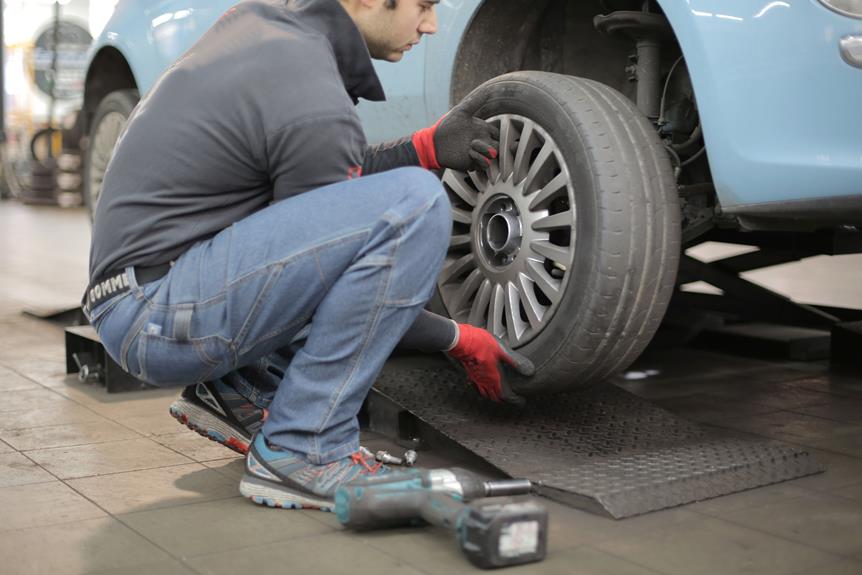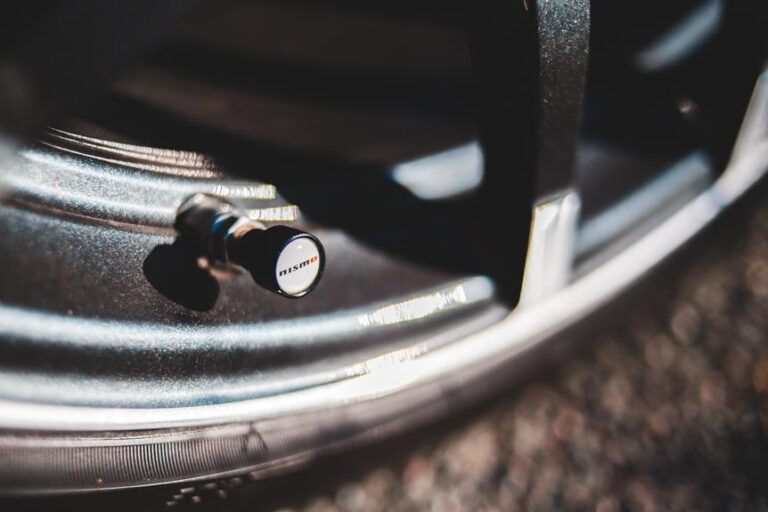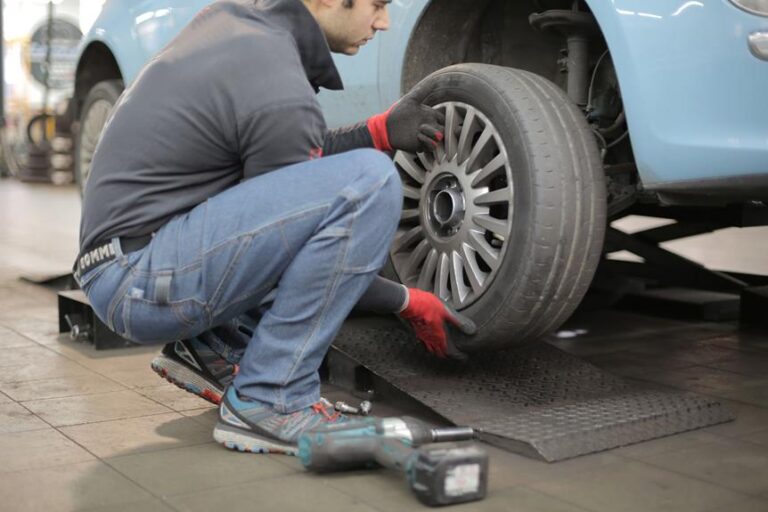Winter Tire Maintenance: Dos and Don'ts
In the frosty months, safeguarding your vehicle's performance and your safety on the wintry roads requires meticulous attention to winter tire maintenance.
This informative article presents a comprehensive guide to the dos and don'ts of winter tire care. From selecting the right winter tires to monitoring tread depth and tire wear, this expertly crafted piece offers precise and detailed advice for ensuring optimal tire performance.
Equip yourself with the necessary knowledge to navigate the snowy terrain with confidence.
Key Takeaways
- Choose winter tires from reputable manufacturers known for durability, traction, and performance in winter conditions.
- Properly inflate your tires to the manufacturer's recommended levels for better fuel efficiency, traction, and control.
- Store winter tires in a suitable location, clean and inspect them before storage, and rotate them every month to prevent flat spots.
- Avoid mixing different tire types to prevent compatibility issues, compromised performance, and safety concerns.
Dos: Choosing the Right Winter Tires
When considering the safety and performance of your vehicle during winter months, one of the most crucial dos is carefully selecting the appropriate winter tires. Choosing the right brand and considering tire size are essential factors to ensure optimal performance on icy and snowy roads.
When it comes to choosing the right brand, it's important to do your research and select a reputable manufacturer known for producing high-quality winter tires. Look for brands that have a proven track record of durability, traction, and performance in winter conditions. Reading customer reviews and consulting with professionals can help you make an informed decision.
Another important consideration is tire size. It is crucial to choose the correct tire size recommended by your vehicle manufacturer. The size of the tire affects its grip on the road, handling, and overall performance. Using the wrong tire size can negatively impact your vehicle's ability to navigate through winter conditions safely.
Additionally, tire tread depth plays a significant role in winter tire performance. Deeper treads provide better traction on slippery surfaces, allowing your vehicle to grip the road more effectively. Ensure that the winter tires you choose have an appropriate tread depth for optimal performance in snowy and icy conditions.
Don'ts: Neglecting Tire Pressure
Neglecting tire pressure is a common mistake that many drivers make, but it can have serious consequences. Proper tire inflation is crucial for optimal performance and safety on the road.
Failing to maintain the correct tire pressure can lead to decreased fuel efficiency, compromised handling, and even tire blowouts.
Proper Tire Inflation
Maintaining appropriate tire pressure is crucial for optimal vehicle performance, ensuring safety, and extending tire lifespan. Proper tire maintenance involves regularly checking and adjusting tire pressure to the manufacturer's recommended levels.
Here are five key reasons why tire pressure importance cannot be overlooked:
- Improved fuel efficiency: Underinflated tires increase rolling resistance, leading to decreased fuel efficiency and higher fuel consumption.
- Enhanced handling and stability: Properly inflated tires provide better traction and control, improving your vehicle's handling and stability on the road.
- Reduced risk of tire failure: Overinflated or underinflated tires are more prone to blowouts, tread separation, and excessive wear, increasing the risk of accidents.
- Longevity of tires: Maintaining the correct tire pressure helps distribute the vehicle's weight evenly across the tire, preventing premature wear and extending tire lifespan.
- Environmental impact: Proper inflation reduces carbon emissions by ensuring the vehicle runs more efficiently, contributing to a greener environment.
Tire Pressure Importance
One cannot underestimate the significance of proper tire pressure for ensuring optimal vehicle performance and safety. Monitoring tire pressure is crucial, especially during the winter months when temperature fluctuations can significantly affect tire inflation. Cold weather causes tire pressure to drop, leading to underinflated tires that can compromise handling, traction, and fuel efficiency.
Regularly checking tire pressure and adjusting it to the vehicle manufacturer's recommended levels is essential. Additionally, investing in a tire pressure monitoring system can provide real-time information about tire pressure, ensuring early detection of any deviations.
Neglecting proper tire pressure maintenance can have severe consequences, such as increased risk of tire blowouts, reduced braking performance, and decreased fuel efficiency. Therefore, regular monitoring and maintenance are essential to keep both the vehicle and its occupants safe on the road.
Consequences of Neglect
Neglecting proper tire pressure maintenance can have serious consequences on both vehicle safety and performance. Some potential dangers of disregarding tire pressure include:
- Increased risk of accidents: Underinflated tires can lead to poor handling and reduced traction, increasing the risk of accidents, especially in wet or icy conditions.
- Decreased fuel efficiency: Improper tire pressure can result in increased rolling resistance, causing the engine to work harder and consume more fuel.
- Uneven tire wear: Incorrect tire pressure can lead to uneven wear patterns, reducing the lifespan of the tires and requiring premature replacement.
- Reduced braking effectiveness: Insufficient tire pressure can compromise braking performance, leading to longer stopping distances and potentially causing accidents.
- Tire blowouts: Overinflated tires can become more susceptible to blowouts, which can be dangerous and result in loss of control.
Ensuring proper tire pressure is just one aspect of tire maintenance. Another important practice is checking tread depth regularly, which will be discussed in the following section.
Dos: Checking Tread Depth Regularly
Regularly checking the tread depth of your tires is crucial for ensuring their optimal performance and safety on the road. Tires with insufficient tread depth can result in reduced traction, longer braking distances, and an increased risk of hydroplaning. To help you understand the importance of tread depth maintenance and tire rotation frequency, let's take a look at the following table:
| Tire Maintenance | Tread Depth Maintenance | Tire Rotation Frequency |
|---|---|---|
| Dos | Regularly check tread depth using a tread depth gauge | Rotate tires every 5,000 to 8,000 miles or as recommended by the manufacturer |
| Don'ts | Ignore tread wear indicators or signs of uneven wear | Rotate tires too frequently or not at all |
Regularly checking the tread depth of your tires allows you to identify any signs of wear and replace them in a timely manner. Using a tread depth gauge provides an accurate measurement and ensures that your tires are within the recommended range. Additionally, tire rotation is important for promoting even wear and extending the lifespan of your tires. Following the manufacturer's recommendations for tire rotation frequency is essential to maintain optimal performance and maximize the longevity of your tires. By adhering to these dos and don'ts, you can ensure that your tires are in top condition, providing you with the freedom to drive safely and confidently on the road.
Don'ts: Ignoring Tire Rotations
Ignoring tire rotations can lead to uneven wear and decrease the lifespan of your tires, so it is important to prioritize regular rotations.
Tire rotation benefits not only include extending the life of your tires but also improving vehicle performance and safety. By rotating your tires, you ensure that each tire wears evenly, which promotes better traction and handling on the road.
To fully understand the significance of regular tire rotations, consider the following points:
- Increases tire longevity: Rotating your tires helps distribute the wear more evenly, preventing premature wear on certain tires. This can extend the overall lifespan of your tires and save you money in the long run.
- Improves traction: Uneven tire wear can result in decreased traction, especially during wet or icy conditions. Regular rotations ensure that all tires maintain optimal grip, improving your vehicle's ability to stop and maneuver safely.
- Enhances fuel efficiency: When tires wear unevenly, it can cause your vehicle to work harder and consume more fuel. By rotating your tires regularly, you can maintain proper tire inflation and maximize fuel efficiency.
- Preserves warranty: Some tire manufacturers require regular rotations to maintain their warranty coverage. By following the recommended tire rotation frequency, you can ensure that your warranty remains valid.
- Promotes even tread wear: Tire rotations help balance out the wear pattern on each tire, allowing them to wear down at a consistent rate. This results in a smoother ride and reduces the need for early tire replacements.
To reap the full benefits of tire rotation, it is recommended to have them rotated every 5,000 to 7,500 miles or as advised by your vehicle manufacturer. Prioritizing regular tire rotations is a simple and cost-effective way to ensure the longevity and performance of your tires while maintaining safety on the road.
Dos: Properly Storing Winter Tires
Properly storing winter tires is essential for maintaining their performance and longevity during the offseason. When the winter season ends, many people tend to neglect their winter tires, leaving them improperly stored until the next winter comes around. This can result in damage to the tires and a decrease in their overall lifespan. To ensure that your winter tires are in optimal condition when you need them again, it is important to follow proper storage practices.
One of the key factors in proper tire storage is finding a suitable location. The storage area should be cool, dry, and away from direct sunlight. Exposure to extreme heat or cold can cause the rubber to deteriorate, while moisture can lead to the growth of mold and mildew. Additionally, storing tires in direct sunlight can cause the rubber to crack and age prematurely.
Another important aspect of tire storage is how they are positioned. Tires should be stored upright and stacked on top of each other to avoid any deformation. Placing a piece of cardboard or a tire mat between each tire can also help prevent any potential damage. It is also recommended to rotate the tires every month to prevent flat spots from forming.
Lastly, proper cleaning and inspection before storage is crucial. Thoroughly clean the tires with water and a mild soap to remove any dirt or debris. Inspect the tires for any signs of damage or wear, and if necessary, repair or replace them before storing.
Don'ts: Mixing Different Tire Types
Mixing different tire types is a common mistake that many drivers make, but it can have serious consequences. It is important to understand that not all tires are created equal and they have different performance characteristics. When you mix different tire types, it can result in compatibility issues, compromised tire performance, and even safety concerns.
Therefore, it is crucial to always stick to one type of tire for optimal performance and safety on the road.
Tire Type Compatibility
It is essential for drivers to be aware of the potential risks associated with the utilization of incompatible tire types on their vehicles. Mixing different tire types can lead to compromised vehicle performance and safety.
To ensure optimal tire performance and longevity, it is important to follow tire care best practices. Here are some tire maintenance tips that every driver should keep in mind:
- Regularly check tire pressure and ensure it is at the recommended level.
- Rotate tires regularly to promote even wear and extend their lifespan.
- Keep an eye on tire tread depth and replace tires when they reach the minimum requirement.
- Avoid overloading the vehicle, as it can put excessive strain on the tires.
- Maintain proper wheel alignment to prevent uneven tire wear and ensure a smooth ride.
Avoiding Tire Performance Issues
To avoid tire performance issues, drivers should refrain from combining different types of tires on their vehicles, as this can compromise vehicle safety and handling. Mixing different tire types, such as all-season and winter tires, can lead to uneven wear, reduced traction, and poor handling on the road. It is essential to understand that each tire type is designed with specific tread patterns and rubber compounds to perform optimally in certain conditions. Therefore, using mismatched tires can negatively impact overall tire performance and compromise safety on the road.
To avoid such tire problems, it is crucial to follow proper tire maintenance tips. Regularly inspecting tires for any signs of wear, including uneven tread wear, bulges, or cuts, is essential. Maintaining correct tire pressure, rotating tires regularly, and ensuring proper wheel alignment are also important. Additionally, when winter approaches, switching to dedicated winter tires can provide better traction and handling on snowy and icy roads, further enhancing safety.
Safety Concerns With Mixing Types
The safety concerns associated with mixing different types of tires on a vehicle are significant and should not be overlooked. When it comes to tire type compatibility, it is crucial to understand the potential risks involved. Here are some important points to consider:
- Tread Pattern: Mixing tires with different tread patterns can affect traction and handling, especially in wet or snowy conditions.
- Tire Size: Using mismatched tire sizes can lead to uneven wear, decreased stability, and compromised handling.
- Load Capacity: Combining tires with different load capacities can impact the vehicle's weight distribution and stability.
- Speed Rating: Mixing tires with different speed ratings can compromise the vehicle's handling and responsiveness at higher speeds.
- Tire Construction: Combining tires with different construction types, such as radial and bias-ply, can result in uneven wear and reduced performance.
To ensure optimal safety and performance, it is recommended to use tires that are the same type, size, and have similar tread patterns. Consulting with a professional tire dealer or mechanic can provide valuable guidance on tire type compatibility and help avoid potential tire performance issues.
Dos: Monitoring Tire Wear and Damage
Regularly inspecting your tires for signs of wear and damage is essential to ensure optimal performance and safety on the road. By following these tire maintenance tips and tire inspection guidelines, you can prolong the life of your tires and prevent any potential accidents or breakdowns.
Firstly, it is important to check the tire pressure regularly. Underinflated or overinflated tires can result in poor handling, reduced fuel efficiency, and increased risk of blowouts. Use a reliable tire pressure gauge to ensure that your tires are inflated to the manufacturer's recommended PSI.
Secondly, inspect the tread depth of your tires. Worn-out tread can drastically reduce traction, especially in wet or snowy conditions. To check the tread depth, insert a penny into the grooves of the tire. If you can see Lincoln's head, it is time to replace your tires.
Additionally, examine the sidewalls of your tires for any cuts, bulges, or cracks. These can weaken the structural integrity of the tire, increasing the risk of a blowout. If you notice any signs of damage, it is crucial to replace the tire immediately.
Lastly, rotate your tires regularly to ensure even wear. Front tires tend to wear faster than rear tires due to the weight distribution of the vehicle. By rotating the tires, you can extend their lifespan and maintain optimal performance.
Don'ts: Overlooking Wheel Alignment
One of the most crucial aspects of tire maintenance that should not be overlooked is wheel alignment. Proper wheel alignment is essential for ensuring the longevity and performance of your tires.
Neglecting wheel alignment can lead to uneven tire wear, decreased handling, and reduced stability, ultimately compromising your safety on the road.
Importance of Alignment
Neglecting to prioritize wheel alignment can result in compromised handling and decreased tire lifespan. Proper wheel alignment is essential for maintaining the overall performance and safety of a vehicle. Here are some key reasons why wheel alignment should never be overlooked:
- Improved Handling: Correct alignment ensures that the tires are aligned with each other and with the road, providing better control and stability while driving.
- Enhanced Tire Lifespan: Proper alignment reduces uneven tire wear, allowing the tires to wear evenly and last longer.
- Fuel Efficiency: Misaligned wheels can cause unnecessary friction, leading to increased fuel consumption. Alignment helps optimize fuel efficiency.
- Safety: Properly aligned wheels minimize the risk of accidents by improving traction, especially in wet or slippery conditions.
- Cost Savings: Regular wheel alignment can prevent premature tire replacement, saving you money in the long run.
Avoid Uneven Tire Wear
Improper wheel alignment can lead to significant and costly uneven tire wear, compromising the safety and performance of the vehicle. To avoid this issue, it is crucial to understand the importance of regular tire maintenance. Uneven tire wear not only affects the lifespan of the tires but also poses a risk of tire blowouts and hydroplaning.
Tire blowouts occur when there is excessive wear on one side of the tire, causing it to weaken and eventually burst. This can be prevented by ensuring proper wheel alignment, tire rotation, and inflation. Regularly inspecting the tires for signs of wear and tear, such as bulges or cracks, is also essential to identify any potential issues before they escalate.
Hydroplaning, on the other hand, occurs when a layer of water builds up between the tires and the road surface, resulting in a loss of traction. Proper tire tread depth is crucial in preventing hydroplaning. It is recommended to replace tires when the tread depth reaches 4/32 of an inch to ensure optimal performance and safety.
Handling and Stability
When it comes to handling and stability, it is crucial to prioritize proper wheel alignment and not underestimate its impact on the overall performance and safety of the vehicle. A well-aligned vehicle ensures that all four wheels are pointing in the same direction, providing better control and maneuverability. In icy road conditions, where grip is already compromised, precise handling techniques become even more important.
Here are some key points to consider:
- Regularly check and adjust wheel alignment to maintain optimal handling.
- Ensure proper tire pressure to maximize traction on icy roads.
- Rotate tires regularly to promote even wear and prolong tire life.
- Use tires with appropriate tread depth for enhanced grip on slippery surfaces.
- Consider investing in winter tires specifically designed for icy road conditions.
Now, let's move on to the dos and don'ts of using tire chains safely to further enhance your winter driving experience.
Dos: Using Tire Chains Safely
To ensure optimal traction during icy road conditions, it is essential to properly install and maintain tire chains throughout the winter season. Using tire chains effectively can significantly improve a vehicle's grip on the road, reducing the risk of accidents and providing peace of mind for drivers. The proper installation of tire chains is crucial to ensure their effectiveness and prevent any damage to the vehicle or the chains themselves.
Here are some dos for using tire chains safely:
- Choose the right chains: Select tire chains that are specifically designed for your vehicle's tire size and recommended for the type of road conditions you will be driving in. Consult your vehicle's manual or a tire professional for guidance.
- Practice installation: Familiarize yourself with the installation process before hitting the snowy roads. This will help you install the chains quickly and correctly when needed.
- Regularly inspect and maintain: Regularly check the condition of your tire chains for any signs of wear, damage, or loose components. Follow the manufacturer's instructions for maintenance and ensure proper tension during installation.
Don'ts: Delaying Tire Replacement When Necessary
Delaying necessary tire replacement can pose serious safety risks to drivers and passengers, compromising their vehicle's performance and increasing the likelihood of accidents. It is important to understand the potential consequences of neglecting tire maintenance and prioritize timely replacement when needed.
Here are some key reasons why delaying tire replacement can be detrimental:
- Decreased traction: Worn-out tires have reduced grip on the road, especially in wet or icy conditions, increasing the risk of skidding or loss of control.
- Longer braking distance: Bald or damaged tires take longer to stop a vehicle, which can be critical in emergency situations where split-second reactions are required.
- Increased hydroplaning risk: Tires with inadequate tread depth are more prone to hydroplaning, where water cannot be properly dispersed, leading to loss of steering control.
- Uneven tire wear: Delaying tire replacement can lead to uneven wear patterns, causing imbalances and potentially damaging other components of the vehicle's suspension system.
- Tire blowouts: Old and worn tires are more susceptible to sudden blowouts, which can result in loss of control and potentially serious accidents.
To ensure the safety and well-being of all occupants, it is essential to prioritize tire maintenance and promptly replace worn-out or damaged tires. By doing so, drivers can enjoy enhanced traction, improved braking performance, and reduced risks on the road.
Frequently Asked Questions
Can I Use My Summer Tires in Winter if I Don't Drive in Snowy Conditions?
Using summer tires in winter, even without driving in snowy conditions, is not recommended. Winter tires provide better traction, handling, and braking in cold weather and icy conditions, ensuring safety on the road.
How Often Should I Check My Tire Pressure During the Winter?
During the winter season, it is important to regularly check tire pressure to ensure optimal performance and safety. Properly storing winter tires and utilizing tire pressure monitors can provide numerous benefits in maintaining tire health and vehicle control.
What Are the Signs of Tire Wear and Damage That I Need to Look Out For?
It is important to regularly check for signs of tire wear and damage. These signs can include uneven tread wear, cracks or bulges in the sidewall, and excessive vibration or noise while driving.
Are There Any Specific Storage Requirements for Winter Tires?
Winter tire storage tips are essential to ensure the longevity and performance of your tires. Properly storing winter tires involves cleaning, inflating to the recommended pressure, and storing them in a cool, dry place away from direct sunlight and chemicals.
Can I Use Tire Chains on All Types of Winter Tires?
Using tire chains on winter tires can provide increased traction on icy roads, but it is important to consider the pros and cons. While chains can enhance grip, they may also cause damage to the tires and road surfaces, and can be noisy and cumbersome to install.
Conclusion
In conclusion, proper maintenance of winter tires is crucial for ensuring optimal performance and safety on icy and snowy roads.
By choosing the right tires, regularly checking tire pressure and tread depth, and properly storing them during the off-season, drivers can extend the lifespan of their winter tires.
Additionally, monitoring tire wear and damage, aligning the wheels correctly, and using tire chains safely are essential practices to enhance traction and handling.
Neglecting these maintenance dos and don'ts may result in compromised performance and increased risk on winter roads.







